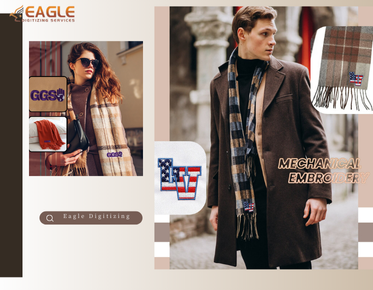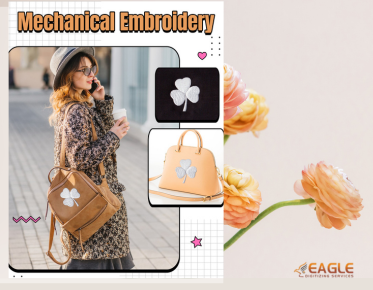Choose Wisely: Embroidery File Formats by Fabric Type
In the realm of embroidery,
the interplay between fabric type and file format is crucial. Selecting the
appropriate file format based on the fabric can transform a simple design into
a stunning piece of art. Different materials possess unique characteristics
that influence how designs are executed, making it imperative to understand
this relationship. The fabric’s texture, weight, and flexibility all play a
pivotal role in the embroidery process. To navigate this intricate landscape
effectively, one must grasp the fundamentals of both fabric types and the
corresponding file formats.
Exploring Popular Embroidery File Formats
DST:
The Industry Standard and Its Ideal Uses
DST (Data Stitch
Tajima) is widely regarded as the industry standard for embroidery digitizing.
Its simplicity and compatibility with various machines make it a reliable
choice for many embroiderers. DST files effectively communicate stitch commands
to embroidery machines, but they lack detailed color information. This format
is particularly well-suited for designs that emphasize stitch accuracy over
color complexity, making it ideal for logos and simpler graphics on natural
fabrics like cotton.
PES:
A Favorite for Brother Machines
PES files are the
go-to choice for Brother embroidery machines, offering a wealth of features
that enhance design versatility. This format supports multiple colors and
intricate designs, making it perfect for projects that require detailed artwork
on synthetic fabrics like polyester. PES files allow for precise stitch
placement, ensuring that every nuance of the design is captured beautifully,
which is essential when working with vibrant, synthetic materials.
JEF:
The Janome Choice for Quality
JEF files are
tailored for Janome machines, providing a balance of detail and simplicity.
This format is known for its ability to handle complex designs while
maintaining a manageable file size. JEF is especially effective on natural
fabrics like linen, where maintaining design integrity is crucial. The format
supports a variety of stitch types, making it versatile enough for diverse
embroidery projects.
EXP:
Melco's Format for Versatile Designs
EXP files are
designed for Melco embroidery machines and are celebrated for their
adaptability. This format allows for advanced stitch types and is ideal for
intricate designs that demand a high level of detail. EXP files are
particularly effective on synthetic fabrics, where the precise execution of
complex designs is essential. This format’s versatility makes it a valuable
tool for any embroiderer looking to explore diverse design possibilities.
Understanding How Fabric Affects File Format Choices
The
Impact of Fabric Thickness on File Format Selection
Fabric thickness
significantly influences the choice of file format. Thicker materials, such as
canvas or wool, require file formats that can accommodate denser stitch
patterns without compromising quality. Conversely, thinner fabrics like tulle
or lightweight cotton necessitate formats that allow for lighter stitching and
more delicate handling. Selecting a file format that aligns with the fabric
thickness ensures that the final embroidery maintains its integrity and
appearance.
Stretch
and Flexibility: Which Formats Work Best?
When working with
stretchy fabrics, such as knits or spandex, the choice of file format becomes
even more critical. Formats like PES or JEF, which offer flexible stitch
options, are ideal for these materials. These formats allow for the creation of
designs that can move with the fabric, preventing puckering and distortion
during wear. Understanding the stretch characteristics of the fabric ensures
that the final embroidery looks as good as it feels.
How
Fabric Texture Influences Stitch Types and Density
The texture of
the fabric plays a pivotal role in determining stitch types and density. Smooth
fabrics like satin allow for finer stitches, while textured fabrics like velvet
require heavier stitching to avoid flattening the fibers. Adjusting the stitch
density based on the fabric's texture is essential for achieving a balanced
look. A thoughtful approach to this relationship ensures that designs are
executed beautifully, regardless of the material.
Choosing the Right File Format for Natural Fabrics
Best
Practices for Digitizing Cotton and Linen
When digitizing
cotton and linen, it’s essential to choose file formats that enhance their
natural properties. Formats like DST and JEF are particularly effective,
allowing for clean stitching and excellent detail retention. Use underlay
stitches to stabilize the fabric and prevent puckering. Additionally, opting
for vibrant colors can elevate the overall appearance, making the most of these
beloved natural materials.
File
Formats That Enhance Wool Embroidery
Wool embroidery
demands careful consideration of stitch density and type. Using file formats
like EXP, which supports complex designs, can help capture the richness of
wool. It’s essential to adjust the stitch density to prevent the fabric from
becoming too heavy, which could distort the design. By selecting the right
format and carefully managing stitch settings, wool can become a stunning
canvas for intricate embroidery.
Managing
Color and Detail on Natural Fibers
Color management
is vital when working with natural fibers. Formats like PES allow for precise
color placement, ensuring that the embroidery pops against the fabric. Take
advantage of the natural sheen of cotton and linen by choosing colors that
enhance their inherent beauty. Paying attention to detail in the file format
selection can lead to remarkable results that highlight the fabric's qualities.
Optimal File Formats for Synthetic Fabrics
Why
PES and JEF Are Great for Polyester
PES and JEF file
formats are particularly well-suited for polyester, offering the flexibility
and precision needed to bring designs to life. Both formats support vibrant
color palettes and intricate stitch types, making them ideal for complex
designs. Polyester’s durability and resistance to fading mean that using these
formats can yield results that remain vivid and beautiful even after repeated
washes.
Handling
Nylon: Tips for Choosing the Right Format
Nylon presents
unique challenges due to its lightweight and flexible nature. Opting for
formats like JEF or PES, which accommodate a variety of stitch types, allows
for better management of the material. It’s crucial to adjust stitch density to
avoid puckering while ensuring that the design retains its integrity. With the
right format, nylon can serve as a striking backdrop for stunning embroidery.
Best
File Formats for Blends: Finding the Right Balance
When working with
blended fabrics, finding the right file format is key to achieving the desired
outcome. Blends may combine the strengths of both natural and synthetic
materials, requiring a careful balance in stitch density and type. PES and JEF
formats are excellent choices, as they offer the versatility needed to adapt to
the fabric's unique characteristics. Experimenting with different formats can
help identify the perfect match for your specific blend.
Specialty Fabrics: Unique Considerations for Digitizing
Working
with Delicate Fabrics Like Tulle
Tulle’s delicate
nature requires meticulous attention when choosing file formats. Formats like
PES, which allow for lighter stitching, are ideal for maintaining the integrity
of this airy fabric. It’s essential to avoid heavy underlay stitches, as they
can damage the material. When digitizing tulle, prioritize designs that
emphasize the fabric’s lightness, creating an ethereal final product.
The
Right Formats for Heavier Materials Like Canvas
For heavier
materials like canvas, robust file formats such as EXP are recommended. These
formats can accommodate the thicker fibers and allow for denser stitching
without compromising quality. It’s important to choose stitch types that
enhance durability while ensuring that the design remains visually appealing.
By selecting the right format, the canvas can serve as a durable and attractive
canvas for intricate embroidery.
Tips
for Digitizing Embroidery on Stretch Fabrics
Digitizing for
stretch fabrics requires a nuanced approach. Formats like JEF or PES are ideal,
as they allow for flexibility in stitch types. It’s crucial to adjust the
stitch density to prevent distortion and ensure that the design moves with the
fabric. Incorporating underlay stitches can provide additional support,
maintaining the design's integrity. Attention to these details will yield
beautiful results on stretch fabrics.
Exploring the Relationship Between Stitch Types and File Formats
How
Stitch Types Vary by Fabric and Format
Stitch types play
a significant role in the quality of embroidery, and their effectiveness can
vary based on the fabric and file format used. Different fabrics require
specific stitch types to achieve the desired look and feel. For instance, satin
stitches are excellent for smooth fabrics, while fill stitches work well on
textured materials. Understanding how these elements interact is crucial for
successful embroidery.
Choosing
the Right Stitch Density for Different Fabrics
Stitch density is
a vital factor that impacts the final appearance of the embroidery. Different
fabrics require varying densities to achieve a balanced look. For delicate
materials, lower density may be necessary to avoid overwhelming the fabric,
while heavier materials may benefit from denser stitching. Adjusting stitch
density based on the fabric type ensures a polished and professional finish.
Balancing
Underlay and Top Stitching for Quality
Achieving
high-quality embroidery involves balancing underlay and topstitching. Underlay
stitches provide stability and support, while top stitches add detail and
finish. The choice of file format influences how these stitches are executed.
Formats like PES or JEF allow for effective management of both stitch types,
resulting in clean and professional-looking embroidery.
Testing and Adjusting Your File Formats
The
Importance of Test Stitching on Different Fabrics
Test stitching is
an indispensable step in the embroidery process. It provides an opportunity to
evaluate how the design interacts with the chosen fabric and file format. By
conducting test stitches, potential issues can be identified early, allowing
for adjustments before the final production. This practice ensures that the end
product meets the desired quality and aesthetics.
Common
Issues to Watch Out for Based on Fabric Type
Each fabric type
presents unique challenges during the embroidery process. Natural fabrics may
fray or pucker if not digitized correctly, while synthetic fabrics might
exhibit thread tension issues. Awareness of these common pitfalls allows for
proactive troubleshooting, ensuring a smoother embroidery experience. Regular
testing and adjustments are essential for addressing these challenges
effectively.
Adjustments
to Make for Optimal Results
Once test
stitching is complete, it’s crucial to analyze the results critically.
Adjustments may include modifying stitch density, altering color placements, or
changing stitch types based on the fabric’s performance. Fine-tuning these
aspects ensures that the final design aligns with your vision, resulting in ahigh-quality embroidery piece.
Choosing the right embroidery digitizing file format based on fabric type is essential for achieving outstanding results. Each project presents its unique challenges, but with thoughtful consideration and experimentation, embroiderers can find the perfect match for their designs. Embrace the journey of discovery, and don’t shy away from trying new formats and techniques. The interplay between fabric and file formats is a dynamic one, and mastering it can elevate your embroidery work to new heights. Happy stitching!



